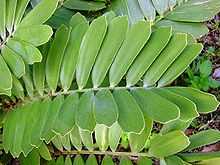Zamia
| Zamia | |
|---|---|
 | |
| Zamia furfuracea | |
| Scientific classification | |
| Kingdom: | Plantae |
| Division: | Cycadophyta |
| Class: | Cycadopsida |
| Order: | Cycadales |
| Family: | Zamiaceae |
| Genus: | Zamia L.[1] |
| Species | |
|
See text | |
Zamia is a genus of cycad of the family Zamiaceae, containing around 50 species, native to North, Central and South America. Species occur as far north as Georgia in the United States (Z. integrifolia; the only cycad native to the United States) to as far south as Bolivia (Z. boliviana).

The genus comprises deciduous shrubs with aerial or subterranean circular stems, often superficially resembling palms. They produce spirally arranged, pinnate leaves which are pubescent, at least when young, having branched and simple, transparent and coloured hairs. The articulated leaflets lack a midrib, and are broad with subparallel dichotomous venation. Lower leaflets are not reduced to spines, though the petioles often have prickles. The emerging leaves of many Zamia species are striking, some emerging with a reddish or bronze cast (Z. roesli is an example). Zamia picta is even more distinctive, being the only truly variegated cycad (having whitish/yellow speckles on the leaves).
Zamia sporophylls are born in vertical rows in cones, and the megasporophyll apices are faceted or flattened, not spinose. The fleshy seeds are subglobular to oblong or ellipsoidal, and are red, orange, yellow or rarely white. The endosperm is haploid, derived from the female gametophyte. The embryo is straight, with two cotyledons that are usually united at the tips and a very long, spirally twisted suspensor.
The sperm of the genus are large, as is typical of cycads, and Zamia roezlii is an example; its sperm are approximately 0.4 mm long and can be seen by the unaided eye.[2]
All the species of Zamia produce leafy crowns of foliage that make them choice garden specimens and most varieties branch heavily in age to produce handsome clumps. With a few exceptions, most Zamia species are found in warm, humid, tropical rainforest habitats, growing in the forest understory. However, many species are still fairly adaptable, performing quite well in cultivation, especially in subtropical areas. All species need good drainage and protection from the cold.
At least one species, Z. pseudoparasitica, grows as an epiphyte in the branches of trees.
The name Zamia comes from the Greek azaniae, meaning "a pine cone".
Selected species
Formerly placed here
- Encephalartos cycadifolius (Jacq.) Lehm. (as Z. cycadifolia Jacq.)
- Encephalartos horridus (Jacq.) Lehm. (as Z. horrida Jacq.)
- Encephalartos longifolius (Jacq.) Lehm. (as Z. longifolia Jacq.)
- Macrozamia spiralis (Salisb.) Miq. (as Z. spiralis Salisb.)
- Microcycas calocoma (Miq.) A. DC. (as Z. calocoma Miq.)[3]
Notes
| Wikimedia Commons has media related to Zamia. |
| Wikispecies has information related to: Zamia |
- ↑ "Genus: Zamia L.". Germplasm Resources Information Network. United States Department of Agriculture. 2007-10-05. Retrieved 2011-01-12.
- ↑ Armstrong, W.P. (2008-04-03). "Botanical Record-Breakers (Part 1 of 2)". Wayne's Word. Retrieved 2011-01-12.
- ↑ "GRIN Species Records of Zamia". Germplasm Resources Information Network. United States Department of Agriculture. Retrieved 2011-01-12.
External links
Further reading
- Lindström, A.J. and Idárraga, Á. (2009). Zamia incognita (Zamiaceae): the exciting discovery of a new gymnosperm from Colombia. Phytotaxa 2: 29-34.